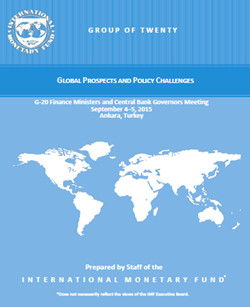Related Links
Group of Twenty IMF Note — G-20 Finance Ministers and Central Bank Governors Meeting
IMF Note on Global Prospects and Policy Challenges
September 4-5, 2015
The Following executive summary is from a note by the Staff of the IMF prepared for the September 4-5, 2015 G-20 Finance Ministers and Central Bank Governors Meeting in Ankara, Turkey.
Read the Full text ![]()
Executive Summary
Global growth remains moderate, reflecting a further slowdown in emerging economies and a weak recovery in advanced economies. In an environment of rising financial market volatility, declining commodity prices, weaker capital inflows, and depreciating emerging market currencies, downside risks to the outlook have risen, particularly for emerging markets and developing economies.
Global growth in the first half of 2015 was lower than in the second half of 2014, reflecting a further slowdown in emerging economies and a weaker recovery in advanced economies. In advanced economies, weaker exports, partly reflecting temporary factors, and a slowdown in domestic demand were key factors. Productivity growth has been persistently weak. In emerging economies, the slowdown reflects a continuation of the adjustment after the investment and credit boom post-crisis, together with the fallout from declining commodity prices, geopolitical tensions, and conflict in a number of countries. In advanced economies, economic activity is projected to pick up modestly in the 2nd half of the year and into 2016. In emerging economies growth this year is projected to slow again relative to 2014; some rebound is projected next year, as conditions in distressed economies, while remaining difficult, are projected to improve.
Financial conditions for emerging economies have tightened. In an environment of rising financial market volatility, dollar bond spreads and long-term local currency bond yields have increased relative to the spring, stock prices have weakened, and capital inflows have declined. Emerging market currencies have generally depreciated, reflecting weakening commodity prices, concerns about the growth transition in China, an increase in risk aversion, and expectations of a lift-off in policy rates in the United States. In contrast, financial conditions in advanced economies continue to be easy. On the back of weak demand, safe real interest rates remain low, despite some widening of spreads, even as the policy rate lift-off approaches in the United States.
Risks are tilted to the downside, and a simultaneous realization of some of these risks would imply a much weaker outlook. Near-term downside risks for emerging economies have increased, given the combination of China's growth transition, lower commodity prices, potential adverse corporate balance sheet and funding challenges related to a dollar appreciation, and capital flow reversals and disruptive asset price shifts.
Strong mutual policy action is needed to raise growth and mitigate risks:
- Advanced economies should maintain supportive policies. In most advanced economies substantial output gaps and below-target inflation suggest that the monetary stance must stay accommodative. Fiscal policy should remain growth friendly and be anchored in credible medium-term plans. Managing high public debt in a low-growth and low-inflation environment remains a key challenge.
- In many emerging economies, policy space to support growth remains limited. The commodity price declines over the past year have alleviated inflation pressures and mitigated external vulnerabilities in net commodity importers, but increased external and fiscal vulnerabilities in commodity exporters. Oil exporters that have accumulated savings and have fiscal space can let fiscal deficits increase and allow a more gradual adjustment of public spending. For floaters with less policy space, exchange rate flexibility will be a critical buffer to the shock. This may require improving macroeconomic policy frameworks in some countries and keeping balance sheet exposures manageable.
- Decisive structural reforms are needed to raise potential output and productivity across the G-2members. Labor market reforms in advanced economies undergoing population aging should aim at raising labor participation, and actions to increase labor demand and remove impediments to employment are also needed in euro area economies and some emerging markets. Reforms to improve the functioning of product markets are also needed in Japan and the euro area, and reforms to improve productivity and raise potential output are key in many emerging economies. Joint policy efforts by deficit and surplus economies are needed to reduce excess imbalances while sustaining growth.
Read the Full text ![]()













